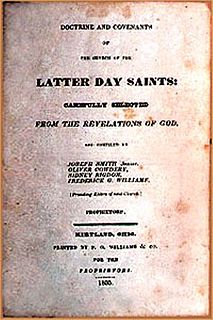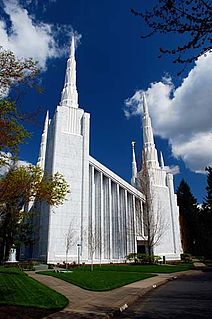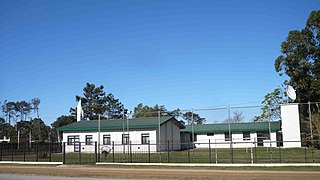Sources
- ↑ "Archives West: Mario S. De Pillis papers, 1957-2008" . Retrieved 18 March 2017.
- ↑ "Mario S. De Pillis Sr. 1926 - 2021". Daily Hampshire Gazette. Retrieved 3 December 2021.
Mario S. De Pillis (January 22, 1926, in Philadelphia, Pennsylvania [1] - November 18, 2021) was an emeritus professor of American Religious history at the University of Massachusetts Amherst. De Pillis specialized in the history of such groups as the Latter-day Saints and Shakers. He was the second president of the Mormon History Association who was not a member of The Church of Jesus Christ of Latter-day Saints, any other Latter-day Saint movement church, or a former member of any such church. [2]
De Pillis had a bachelor's and master's degree from the University of Chicago and a Ph.D. from Yale University.
De Pillis and his wife, the former Freda M. Rustemeyer, were the parents of three sons. De Pillis was a Catholic.[ citation needed ]

The Church of Jesus Christ of Latter-day Saints, often informally known as the LDS Church or Mormon Church, is a nontrinitarian, Christian church that considers itself to be the restoration of the original church founded by Jesus Christ. The church is headquartered in the United States in Salt Lake City, Utah, and has established congregations and built temples worldwide. According to the church, it has over 16.8 million members and 54,539 full-time volunteer missionaries. The church is the fourth-largest Christian denomination in the United States, with over 6.7 million US members as of 2021. It is the largest denomination in the Latter Day Saint movement founded by Joseph Smith during the early 19th-century period of religious revival known as the Second Great Awakening.

Mormons are a religious and cultural group related to Mormonism, the principal branch of the Latter Day Saint movement started by Joseph Smith in upstate New York during the 1820s. After Smith's death in 1844, the movement split into several groups following different leaders; the majority followed Brigham Young, while smaller groups followed Joseph Smith III, Sidney Rigdon, and James Strang. Most of these smaller groups eventually coalesced into the Community of Christ, and the term Mormon typically refers to members of The Church of Jesus Christ of Latter-day Saints, as today this branch is far larger than all the others combined. Since 2018, the LDS Church has requested that its members be referred to as "Latter-day Saints". People who identify as Mormons may also be independently religious, secular and non-practicing, or belong to other denominations.

Mormonism is the religious tradition and theology of the Latter Day Saint movement of Restorationist Christianity started by Joseph Smith in Western New York in the 1820s and 1830s. As a label, Mormonism has been applied to various aspects of the Latter Day Saint movement, although there has been a recent push from The Church of Jesus Christ of Latter-day Saints to distance themselves from this label. A historian, Sydney E. Ahlstrom, wrote in 1982, "One cannot even be sure, whether [Mormonism] is a sect, a mystery cult, a new religion, a church, a people, a nation, or an American subculture; indeed, at different times and places it is all of these". However, scholars and theologians within the Latter Day Saint movement, including Smith, have often used "Mormonism" to describe the unique teachings and doctrines of the movement.

The "Word of Wisdom" is the common name of an 1833 section of the Doctrine and Covenants, a book considered by many churches within the Latter Day Saint movement to be a sacred text. The section defines beliefs regarding certain drugs, nutritious ingredients in general, and the counsel to eat meat sparingly; it also offers promises to those who follow the guidance of the Word of Wisdom.

The Latter Day Saint movement is the collection of independent church groups that trace their origins to a Christian Restorationist movement founded by Joseph Smith in the late 1820s.

Emma Hale Smith Bidamon was the wife of Joseph Smith and a leader in the early days of the Latter Day Saint movement, both during Joseph's lifetime and afterward as a member of the Reorganized Church of Jesus Christ of Latter Day Saints. In 1842, when the Ladies' Relief Society of Nauvoo was formed as a women's service organization, she was elected by its members as the organization's first president.

Ensign College is a private college in Salt Lake City, Utah. The college is owned by The Church of Jesus Christ of Latter-day Saints and operates under its Church Educational System. It also includes an Institute of Religion and is accredited by the Northwest Commission on Colleges and Universities.
The Mormons is a four-hour PBS documentary about The Church of Jesus Christ of Latter-day Saints. The production originally aired in two-hour segments on April 30 and May 1, 2007. It was produced by Helen Whitney, and was the first joint production of Frontline and American Experience.
Richard Lloyd Anderson was an American lawyer and theologist of The Church of Jesus Christ of Latter-day Saints who was a professor of church history and doctrine at Brigham Young University (BYU). His book Investigating the Book of Mormon Witnesses is widely considered the definitive work on this subject. Anderson was the brother of Karl Ricks Anderson.

Mormonism and Nicene Christianity have a complex theological, historical, and sociological relationship. Mormons express their doctrines using standard biblical terminology and have similar views about the nature of Jesus Christ's atonement, bodily resurrection, and Second Coming as traditional Christianity. Nevertheless, most Mormons do not accept the Trinitarian doctrine of Nicene Christianity, codified in the Nicene and Nicene-Constantinopolitan Creeds of 325 and 381. Although Mormons consider the Protestant Bible as scripture, they do not believe in biblical inerrancy. They have also adopted additional scriptures that they believe to have been divinely revealed to Joseph Smith, including the Book of Mormon, the Doctrine and Covenants, and the Pearl of Great Price. Mormons practice baptism and celebrate the sacrament, but they also participate in other religious rituals. Mormons self-identify as Christians.

The Church of Jesus Christ of Latter-day Saints in Oregon refers to The Church of Jesus Christ of Latter-day Saints and its members in Oregon. Oregon has the 9th most members of the Church of any U.S. state. Members have had considerable influence in the state throughout its contemporary history and many influential Mormons have come from Oregon including Senator Gordon H. Smith.

The Church of Jesus Christ of Latter-day Saints has had a presence in France since 1849, and the first Latter-day Saint convert in the country was Augustus Saint d'Anna, in Le Havre. The Church claims a membership of about 39,000 in the country, representing less than 0.1% of the population.

The Church of Jesus Christ of Latter-day Saints was established in Brazil in 1926 with the opening of the South American Mission. Missionary work was focused on small German immigrant colonies in South Brazil. The LDS Church was forced to expand missionary work to Brazilians and Portuguese speakers when non-Portuguese languages were banned in public meetings in 1938. The Brazil Mission was opened on February 9, 1935 with Rulon S. Howells as mission president. The first Book of Mormon translated into Portuguese was published in 1939.

The Church of Jesus Christ of Latter-day Saints was established in Argentina in 1925 when Melvin J. Ballard arrived in Buenos Aires and opened the church's South American Mission. K.B. Reinhold Stoof became the first president of the South American Mission in July 1926. Missionary work largely focused on populations of German immigrants. After Stoof's release in 1935, the South American Mission split into the Brazilian Mission and the Argentine Mission. During World War II, missionaries were required to leave Argentina but then re-entered in 1947. The Argentine Mission divided again in 1962 and the first stake in Argentina was established in 1966 in Buenos Aires. The Buenos Aires Argentina Temple was dedicated on January 17, 1986, becoming the church's first temple in Argentina.

The Church of Jesus Christ of Latter-day Saints in Uruguay refers to The Church of Jesus Christ of Latter-day Saints and its members in Uruguay. The first small branch was established in 1947. Since then, the LDS Church in Uruguay has grown to more than 100,000 members in 134 congregations. Uruguay has more LDS Church members per capita than the United States, as well as more members per capita than any country outside of Oceania and Chile.

The Church of Jesus Christ of Latter-day Saints in Germany refers to The Church of Jesus Christ of Latter-day Saints and its members in Germany.

The Church of Jesus Christ of Latter-day Saints has had a presence in the island of Ireland since at least 1840, when the Mormon missionary John Taylor first preached in Newry. He and other missionaries converted a number of Irish people, forming a branch in Hillsborough, County Down. Many of the converted Irish saints emigrated in order to escape poverty, as well as to live in majority Latter Day Saint communities. Missionary efforts continued in the 1850s and a small branch was established in Dublin, but many members emigrated to Utah or lost interest in the church, and in 1867 the Irish mission was placed in the care of the British mission. A new branch was formed in Belfast in 1884 and a Dublin branch was reestablished in 1900. All of this occurred despite anti-Mormon disturbances by local Irish people.

The Church of Jesus Christ of Latter-day Saints was first brought to the Netherlands in 1841, with the first congregation officially established in 1862 in Amsterdam. A mission to the Netherlands was organized in 1864, and the Dutch translation of the Book of Mormon was published in 1890. Membership grew in the 20th century despite challenges posed by World War I, the Great Depression, and the German invasion of the Netherlands during World War II; approximately 14,000 people were baptized into the Church during its first 100 years in the Netherlands. The Dutch government officially recognized the Church in 1955. The Netherlands Stake of the Church of Jesus Christ of Latter-day Saints was established in 1961, becoming the first stake established on the European continent. The Hague Netherlands Temple was completed in 2002. Meetings are now canceled due to the ongoing COVID-19 pandemic.